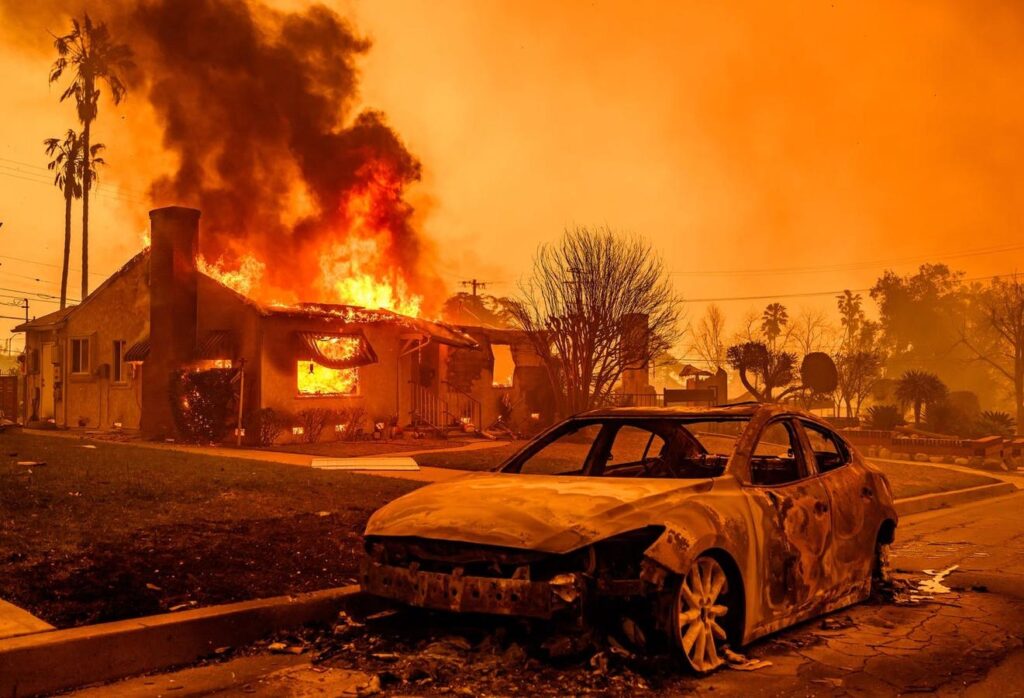The ongoing California fires devastating Los Angeles county and surrounding areas highlight the growing risks posed by climate change, droughts, and expanding residential developments in fire-prone regions. As these natural disasters grow in frequency and intensity, protecting your property and financial stability is more critical than ever. This article discusses the types of insurance that may protect against wildfire damage, some common policy exclusions and gaps, and tips to ensure you’re adequately covered.
Types Of Insurance That May Cover Wildfire Damage
Homeowners Insurance
Homeowners insurance typically covers the cost to repair or rebuild a home if it is damaged or destroyed by a wildfire or other disasters, including the structure itself and any attached structures like garages or decks. It also includes replacement or repair of personal belongings inside the home, such as furniture, electronics, clothing, and appliances.
If a wildfire renders the home uninhabitable, Additional Living Expenses coverage helps pay for temporary housing, meals, and other living costs during repairs.
Renters Insurance
While the landlord’s insurance covers the physical structure of the building, it does not extend to tenants’ personal property. Renters insurance provides coverage for items like electronics, clothing, and furniture damaged by fire.
Renters insurance can also cover the cost of temporary housing and living expenses, ensuring tenants have financial support during the recovery period.
Condo Insurance
Also known as an HO-6 policy, it offers specialized coverage for condo owners who share property ownership with others. While the condo association typically insures the building’s exterior, individual owners are responsible for the unit’s interior and their personal property.
Condo insurance covers the interior walls, flooring, and any improvements or customizations made to the unit. It also protects personal belongings within the condo and provides loss assessment coverage, which safeguards owners if the condo association charges unit owners for damages to shared spaces not fully covered by the association’s insurance.
Landlord Insurance
Landlords need a dwelling fire policy to protect their rental properties from wildfire damage. This type of policy covers the physical structure of the rental property, ensuring repairs or rebuilding costs are handled.
It also compensates landlords for lost rental income if the property becomes unlivable. Landlord insurance also includes liability coverage to protect against legal claims if a tenant is injured due to wildfire-related property damage.
Specialized Wildfire Insurance
For homeowners in high-risk wildfire areas, standard insurance may be insufficient or even unavailable. Specialized wildfire insurance policies offer additional protection by providing extended dwelling coverage with higher limits to cover increased rebuilding costs.
These policies also cover the often costly process of debris removal and protecting landscaping and outdoor features, such as trees, shrubs, and fences. Specialized wildfire insurance bridges the gaps left by standard policies, ensuring comprehensive protection in vulnerable regions.
State And Government Insurance Programs
In regions where private insurers limit coverage due to wildfire risks, state-backed insurance programs serve as a last-resort option for homeowners. For example, the California FAIR Plan is designed for homeowners in high-risk areas who are unable to secure traditional insurance. It covers fire, lightning, and internal explosion damage but often requires supplemental policies for more comprehensive protection.
Other states offer similar high-risk coverage programs to ensure that residents can obtain basic protection against damage from wildfire or other disasters. Contact your state’s insurance department to inquire about available insurance options or specific programs that may exist.
Common Exclusions And Gaps In Wildfire Insurance Coverage
Negligence-Related Damages
Insurance policies often exclude coverage for damages resulting from homeowner negligence. For example, failing to maintain defensible space around a property—such as not clearing dry vegetation or flammable debris—can lead to denied claims if a wildfire damages the home.
Regular maintenance and adherence to safety standards are essential for keeping your policy valid and effective.
Coverage Limits And Rising Costs
Even with a comprehensive policy, homeowners may face financial strain if their coverage limits are too low. Standard policies set maximum payout amounts for dwelling repairs, personal property replacement, and additional living expenses.
With construction materials and labor costs steadily rising, outdated coverage limits can leave homeowners vulnerable to significant out-of-pocket expenses. Periodically reviewing and adjusting coverage limits ensures they align with current rebuilding costs, providing necessary financial protection.
Denials, Cancellations, And Non-Renewals In High-Risk Areas
Homeowners in wildfire-prone regions often struggle to secure adequate insurance coverage. Some insurers may refuse to issue or renew policies in high-risk areas due to increased wildfire threats.
In some cases, policies may be canceled altogether. Other insurers may offer limited or high-premium coverage that leaves critical gaps in protection.
Steps To Ensure Adequate Wildfire Coverage
Review And Update Policies Regularly
As rebuilding costs rise due to inflation, labor shortages, and increased material prices, your existing coverage limits may no longer be sufficient. Schedule annual policy reviews with your insurance provider to ensure that your dwelling and personal property coverage align with current market values.
Update your policy to close potential gaps and adjust for any home improvements or additions that could affect coverage needs.
Increase Coverage Limits
Raising coverage limits for dwelling and personal property can provide financial security in the event of significant wildfire damage. Homeowners should consider purchasing extended replacement cost coverage, which pays for rebuilding costs even if they exceed policy limits.
Updating personal property coverage also ensures that high-value items like electronics, jewelry, and furniture are adequately protected.
Add Wildfire-Specific Endorsements
Standard homeowners insurance policies may not fully cover wildfire-related risks. Adding specific endorsements or riders can enhance your policy by covering additional expenses, such as debris removal, increased rebuilding costs, and landscaping restoration.
Discuss with your insurer what endorsements are available to customize your policy for wildfire and other risks.
Maintain A Home Inventory
Document all personal belongings by taking clear photographs or videos and keeping receipts or appraisals for high-value items. Digital records stored in the cloud or offsite can provide quick access during the claims process.
A comprehensive inventory streamlines the claims process and helps accurately assess the value of lost or damaged items, ensuring that you receive appropriate reimbursement.
Implement Wildfire-Resistant Property Improvements
Different improvements can protect your property from wildfire damage. You can install fire-resistant materials, such as non-combustible roofing, ember-resistant vents, and dual-pane windows, to reduce the risk of ignition.
Reinforce your home by sealing gaps and enclosing eaves to prevent embers from entering the structure. You should also create and maintain defensible space by clearing flammable materials, trimming overhanging branches, and removing dead vegetation around your home. These improvements minimize wildfire risks and may also qualify you for insurance discounts.
Bundle Insurance Policies
Bundle your homeowners insurance with other policies, such as auto, life, or umbrella insurance. Many insurers provide multi-policy discounts, which can make comprehensive wildfire coverage more affordable and accessible.
Aside from cost savings, bundling allows for streamlined billing and a single point of contact for managing claims and coverage inquiries.
Consult With An Insurance Professional
Insurance professionals have in-depth knowledge of various policy options and can tailor coverage to your specific needs. They can help identify hidden coverage gaps, explain the nuances of wildfire endorsements, and recommend additional protections that may not be included in standard policies.
They can also provide advice on how to qualify for premium discounts through wildfire mitigation efforts or bundling policies. During the claims process, a trusted agent can advocate on your behalf, ensuring that documentation is properly submitted and claims are processed efficiently.
Conclusion
Wildfires pose significant threats to property and financial security as highlighted by the California fires. Securing the right insurance coverage, understanding policy details, and implementing fire mitigation measures are essential for protecting your home and assets. Regular policy reviews and staying informed can ensure you have the financial protection needed to recover after a wildfire.
Read the full article here











